
A light cruiser is a type of small or medium-sized warship. The term is a shortening of the phrase "light armored cruiser", describing a small ship that carried armor in the same way as an armored cruiser: a protective belt and deck. Prior to this smaller cruisers had been of the protected cruiser model, possessing armored decks only. While lighter and smaller than other contemporary ships they were still true cruisers, retaining the extended radius of action and self-sufficiency to act independently around the world. Cruisers mounting larger guns and heavier armor relative to most light cruisers would come to be known as heavy cruisers, though the designation of 'light' versus 'heavy' cruisers would vary somewhat between navies. Through their history light cruisers served in a variety of roles, primarily as convoy escorts and destroyer command ships, but also as scouts and fleet support vessels for battle fleets.

A heavy cruiser was a type of cruiser, a naval warship designed for long range and high speed, armed generally with naval guns of roughly 203 mm (8 inches) in calibre, whose design parameters were dictated by the Washington Naval Treaty of 1922 and the London Naval Treaty of 1930. Heavy cruisers were generally larger, more heavily-armed and more heavily-armoured than light cruisers while being smaller, faster, and more lightly-armed and armoured than battlecruisers and battleships. Heavy cruisers were assigned a variety of roles ranging from commerce raiding to serving as 'cruiser-killers,' i.e. hunting and destroying similarly-sized ships.
Kumano (熊野) literally means 'Bear Field'. It is a name adopted by various places in Japan.

The Mogami class (最上型) was a ship class of four cruisers built for the Imperial Japanese Navy (IJN) during the 1930s. They were initially classified as light cruisers under the weight and armament restrictions of the London Naval Treaty. After Japan abrogated that agreement, all four ships were rearmed with larger guns and reclassified as heavy cruisers. All participated in World War II and were sunk.
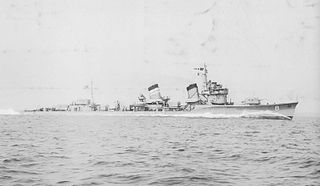
Asagiri was the thirteenth of twenty-four Fubuki-class destroyers, built for the Imperial Japanese Navy following World War I. When introduced into service, these ships were the most powerful destroyers in the world. They served as first-line destroyers through the 1930s, and remained formidable weapons systems well into the Pacific War.
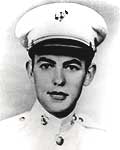
Captain Richard Eugene Fleming was a United States Marine who received the Medal of Honor for his heroism in World War II during the Battle of Midway. Fleming piloted a Vought SB2U Vindicator dive bomber in an attack on the Japanese cruiser Mikuma.
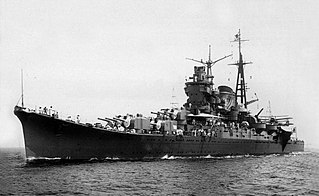
Mogami (最上) was the lead ship in the four-vessel Mogami class of heavy cruisers in the Imperial Japanese Navy. She was named after the Mogami River in Tōhoku region of Japan. The Mogami-class ships were constructed as "light cruisers" with five triple 155-millimetre (6.1 in) dual purpose guns. They were exceptionally large for light cruisers, and the barbettes for the main battery were designed for quick refitting with twin 8-inch (203 mm) guns. In 1937 all four ships were "converted" to heavy cruisers in this fashion. Mogami served in numerous combat engagements in World War II, until she was sunk at the Battle of Leyte Gulf in October 1944.

Kumano (熊野) was one of four Mogami class of heavy cruisers in the Imperial Japanese Navy, serving in World War II. She was named after the Kumano River Kii Peninsula on the island of Honshu in central Japan. The Mogami-class ships were constructed as "light cruisers" with five triple 6.1-inch dual purpose guns. They were exceptionally large for light cruisers, and the barbettes for the main battery were designed for quick refitting with twin 8-inch guns. In 1937 all four ships were "converted" to heavy cruisers in this fashion. Kumano served in numerous combat engagements in the Pacific War, until she was eventually sunk by carrier aircraft from Task Force 38 while she was undergoing repairs at Santa Cruz, Zambales, Philippines, in November 1944.

Mikuma was a heavy cruiser of the Imperial Japanese Navy. The second vessel in the four-ship Mogami class, she was laid down in 1931 and commissioned in 1935. During World War II she participated in the Battle of Sunda Strait in February 1942 and the Battle of Midway in June 1942, and was sunk the last day of the latter engagement, on 6 June.
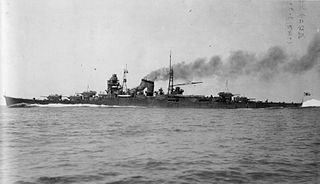
Suzuya (鈴谷) was the third of four vessels in the Mogami class of heavy cruisers in the Imperial Japanese Navy. She was named after the Suzuya River on Karafuto.

Natori (名取) was a Nagara-class light cruiser in the Imperial Japanese Navy. The ship was named after the Natori River in Miyagi prefecture, Japan. Natori was the third vessel completed in the Nagara class of light cruisers. Like other vessels of her class, she was intended for use as the flagship of a destroyer flotilla.

Arashio was the fourth of ten Asashio-class destroyers built for the Imperial Japanese Navy in the mid-1930s under the Circle Two Supplementary Naval Expansion Program.
Ibuki may refer to one of the following ships of the Imperial Japanese Navy named after Mount Ibuki:
Four warships of Japan have been named Mogami, after the Mogami River in the Tohoku region of Honshū:

The Furutaka-class cruisers were a class of two heavy cruisers which saw service with the Imperial Japanese Navy during World War II. Both vessels of this class were sunk in 1942 during the Guadalcanal campaign.
Suzuya may refer to one of two cruisers of the Imperial Japanese Navy, named for the Susuya River in Karafuto:
Three warships of Japan have been named Kumano:
Three warships of Japan have been named Noshiro:
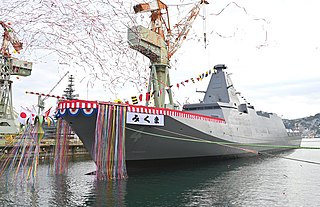
JS Mikuma (FFM-4) is the fourth ship of the Mogami-class frigates of the Japan Maritime Self-Defense Force (JMSDF). She was named after the Mikuma River and shares her name with a World War II heavy cruiser Mikuma and Cold War destroyer escort Mikuma.
This page is based on this
Wikipedia article Text is available under the
CC BY-SA 4.0 license; additional terms may apply.
Images, videos and audio are available under their respective licenses.












